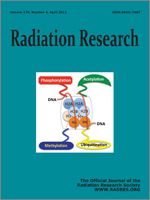Cytogenetic damage is among the few radiobiological end points that allow a precise distinction to be made between misrepaired damage, represented by exchange-type aberrations such as dicentrics and translocations, and unrepaired damage that leads to “open breaks”. This latter category includes both terminal deletions and incomplete exchanges, whose different mechanisms of formation can be recognized by multicolor fluorescence in situ hybridization (mFISH). mFISH was used to examine the yields of chromosome aberrations at the first postirradiation mitosis in human fibroblasts and lymphocytes irradiated with 137Cs γ rays, a radiation of low-linear energy transfer (LET), and two sources of high-LET radiation: α particles from 238Pu and 1 GeV/amu 56Fe ions. In agreement with previous studies, our results show that irrespective of radiation quality, the overall level of misrepaired damage exceeds that of unrepaired damage by a large margin. The unrepaired component of damage produced by γ rays and α particles was remarkably similar, about 5%. On that basis it is difficult to justify the popular notion that the strong LET-dependence for aberration formation is due to unrepaired DNA double-strand breaks (DSBs) that, by virtue of their complexity at the nanometer scale, are qualitatively different in nature. In marked contrast, this unrejoined component rose to about 14% after exposure to Fe ions. A closer look at the unrepaired component revealed that most of this roughly threefold difference was derived from incomplete exchanges. Despite vast differences in LET, unrejoined breaks from incomplete exchanges were far more likely to occur among exchanges that involved more than two breakpoints. We attempted to reconcile these observations in the form of a hypothesis that predicts that exchanges, irrespective of LET, should exhibit an increasing tendency for incompleteness as the number of initial breaks destined to take part in the exchange increases. This effect, we argue is not caused by the number of initial breaks per se, but instead reflects the maximum distance over which proximate breaks can interact. This adds a spatial aspect to multi-break interactions that we call “A Break Too Far”.
How to translate text using browser tools
6 February 2013
The LET Dependence of Unrepaired Chromosome Damage in Human Cells: A Break Too Far?
Bradford D. Loucas,
Michael N. Cornforth
ACCESS THE FULL ARTICLE

Radiation Research
Vol. 179 • No. 4
April 2013
Vol. 179 • No. 4
April 2013




